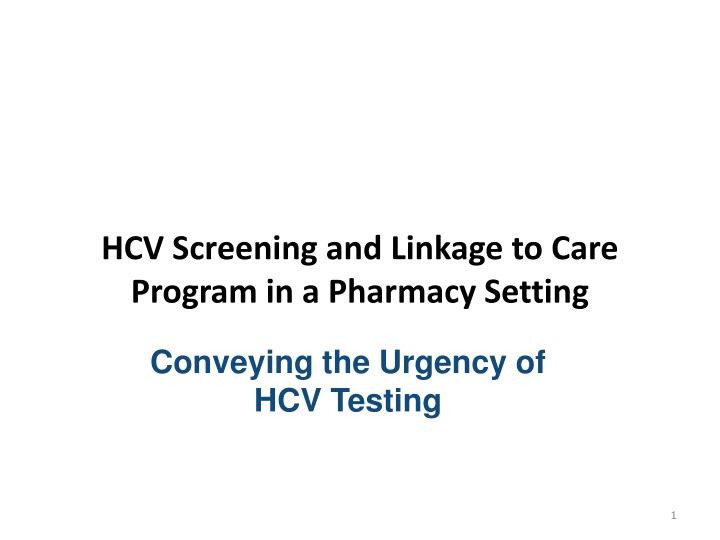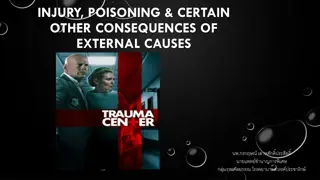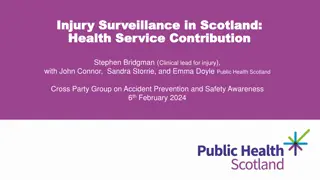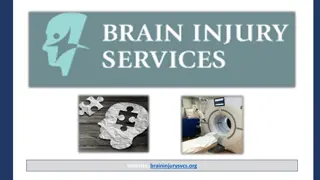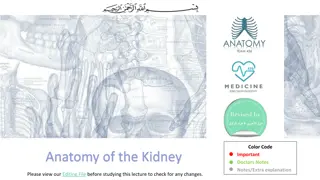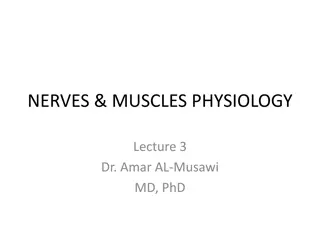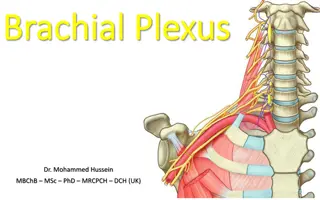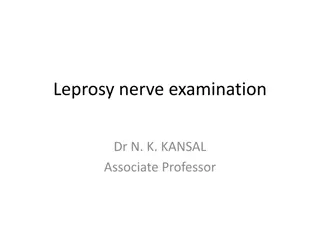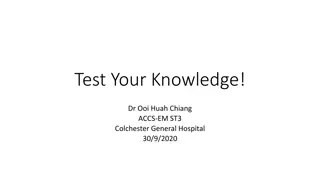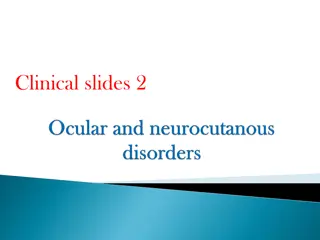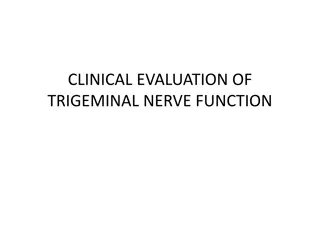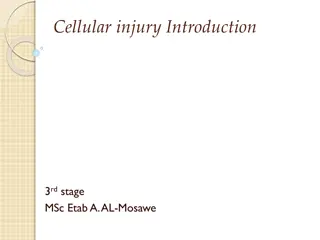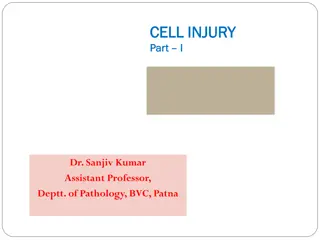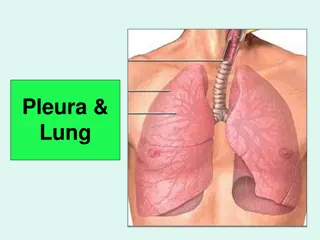Nerve Injury: Anatomy, Classification, Causes, Clinical Features, Management
This presentation delves into the anatomy of nerves, classification of nerve injuries, causes, clinical manifestations, and management strategies. Explore topics like Seddan's and Sunderland's classifications of nerve injuries to enhance your understanding of nerve-related issues.
Download Presentation

Please find below an Image/Link to download the presentation.
The content on the website is provided AS IS for your information and personal use only. It may not be sold, licensed, or shared on other websites without obtaining consent from the author.If you encounter any issues during the download, it is possible that the publisher has removed the file from their server.
You are allowed to download the files provided on this website for personal or commercial use, subject to the condition that they are used lawfully. All files are the property of their respective owners.
The content on the website is provided AS IS for your information and personal use only. It may not be sold, licensed, or shared on other websites without obtaining consent from the author.
E N D
Presentation Transcript
HCV Screening and Linkage to Care Program in a Pharmacy Setting Conveying the Urgency of HCV Testing 1
How to Talk about Hepatitis C Testing 2
Chronic HCV Infection May Lead to Chronic Liver Disease and Liver Cancer as well as Systemic Disease : DM, Renal Disease, Lymphoma and other problems Hepatocellular Carcinoma Fibrosis Cirrhosis (with cirrhosis) HCC3 Cancer of the liver can develop after years of chronic HCV infection Fibrosis1 Chronic HCV infection can lead to the development of fibrous scar tissue within the liver Decompensated cirrhosis: Ascites Bleeding gastroesophageal varices Hepatic encephalopathy Jaundice Cirrhosis1,2 Over time, fibrosis can progress, causing severe scarring of the liver, restricted blood flow, impaired liver function, and eventually liver failure Chronic liver disease includes fibrosis, cirrhosis, and hepatic decompensation; HCC=hepatocellular carcinoma. 1. Highleyman L. Hepatitis C Support Project. http://www.hcvadvocate.org/hepatitis/factsheets_pdf/Fibrosis.pdf. Accessed August 18, 2011; 2. Bataller R et al. J Clin Invest. 2005;115:209-218; 3. Medline Plus. http://www.nlm.nih.gov/medlineplus/enxy.article/000280.htm. Accessed August 28, 2012; 4. Centers for Disease Control and Prevention. http://www.cdc.gov/hepatitis/HCV/HCVfaq.htm. Accessed May 8, 2012. 3
Chronic HCV Infection Affects Many Sites Beyond the Liver Neurological (e.g. cognitive impairment) Cardiovascular Diseases (CAD) Pulmonary fibrosis Renal Metabolic (e.g. diabetes) (e.g. glomerulonephritis) Lymphoproliferative (e.g. B cell lymphoma) Immune Complex (e.g. cryoglobulinemic) Dermatological (e.g. porphyria cutanea tarda)
Identifying Patients with Hepatitis C 4-5 million people in the US have hepatitis C virus (HCV) infection Most were infected in 1960 s through 1980 s Up to 250,000 cases per year in 1980 s About 50% infected via IDU, rest from blood transfusions, sex, tattoos, medical procedures, and other factors Up to 75% of people have not been diagnosed Risk-based screening misses many people Stigma associated with IDU, even if decades ago Smith BD et al. MMWR. August 17, 2012/61(RR04);1-18. Armstrong GL et al. Ann Intern Med. 2006 May 16;144(10):705-14. http://www.iom.edu/Reports/2010/Hepatitis-and-Liver-Cancer-A-National-Strategy-for-Prevention-and-Control-of-Hepatitis-B-and- C.aspx 5
HCV is Nearly 4 Times as Prevalent as HIV and HBV Prevalence of Chronic Viral Infections 2.7 to 5 Million1 75% Unaware of Infection 4 Total No. Infected 3 Undiagnosed (millions) Diagnosed 2 ~800,000 to 1.4 Million1 65% Unaware of Infection 1.1 Million1 21% Unaware of Infection 1 0 HIV HBV HCV A 2011 study estimated that as many as 5.2 million persons are living with HCV in the United States2 HBV=hepatitis B virus; HCV=hepatitis C virus; HIV=human immunodeficiency virus. 1. Institute of Medicine. Washington, DC: The National Academies Press; 2010. 2. Chak E, et al. Liver Int. 2011;31(8):1090-1101. 3. Gish Hepatology 2015
Efficient Identification of Patients with HCV 4 -5 million people with HCV in US 50 million risk identified or ~80 million 1945- 1965 cohort who need to be tested for HCV in US1 25% Treatment and Management diagnosed with HCV Improve Diagnosis 7 1Tomaszewski Am J Public Health 2012; 102 (11):e101
Current Status of HCV in the US: Screening and Linkage to Care Rates Remain Low US population with chronic HCV infection 3.2-5 million HCV detected 1.6 million (25-50%) Referred to care 1.0 1.2 million (<32%-38%) HCV RNA test Liver biopsy 630,000 750,000 (<20-23%) 380,000 560,000 (<12%-18%) Treated 220,000 360,000 (<7-11%) Successfully treated 170,000 200,000 (<5-6%) As modified from: Holmberg SD et al, New Engl J Med. 2013; 1859-1861. as modfied with Gish Hepatology 2015
Who Should Be Tested for HCV CDC Recommendations Everyone born from 1945 through 1965 (one-time) Persons who ever injected illegal drugs Persons who received clotting factor concentrates produced before 1987 Chronic (long-term) hemodialysis Persons with persistently abnormal ALT levels. Recipients of transfusions or organ transplants prior to 1992 Persons with recognized occupational exposures Children born to HCV-positive women HIV positive persons USPSTF Grade B Recs* Everyone born from 1945 through 1965 (one-time) Past or present injection drug use Sex with an IDU; other high-risk sex Blood transfusion prior to 1992 Persons with hemophilia Long-term hemodialysis Born to an HCV-infected mother Incarceration Intranasal drug use Receiving an unregulated tattoo Occupational percutaneous exposure Surgery before implementation of universal precautions 9 *Only pertains to persons with normal liver enzymes; if elevated liver enzymes need HBV and HCV testing Smith at al. Ann Intern Med 2012; 157:817-822. Moyer et al. Ann Intern Med epub 25 June 2013
HCV Testing: Elevated Liver Enzymes? Patients with at least 1 clinical encounter and no previous HCV diagnosis Percent tested for HCV Percent of tested patients who were HCV positive 865,659 13% 5.1% 43.9% Percent patients with 2 elevated ALT results tested for HCV Percent positive for HCV after 2 elevated ALT results 8.2% Study included patients followed at Kaiser Permanente of Hawaii and Oregon, Henry Ford Health System, Detroit, and Geisinger Health System, PA 10 Spradling et al CID 2012; 55:1047-55.
Baby Boomers (Born in 19451965) Account for 76.5% of HCV in the US1 Estimated Prevalence by Age Group2 1.6 Number with chronic HCV (millions) 1.4 1.2 1.0 0.8 0.6 0.4 0.2 0 <192 0 1920s 1930s 1940s 1950s 1960s 1970s 1980s 1990+ Birth Year Group An estimated 35% of undiagnosed baby boomers with HCV currently have advanced fibrosis (F3-F4; bridging fibrosis to cirrhosis)3 11 1. Centers for Disease Control and Prevention. MMWR. 2012;61:1-32; Adapted from Pyenson B, et al. Consequences of Hepatitis C Virus (HCV): Costs of a baby boomer Epidemic of Liver Disease. New York, NY: Milliman, Inc; May 18, 2009. http://www.milliman.com/expertise/healthcare/publications/rr/consequences-hepatitis-c-virus-RR05- 15-09.php Milliman report was commissioned by Vertex Pharmaceuticals; 3. McGarry LJ et al. Hepatology. 2012;55(5):1344-1355.
Estimates of People with HCV in MA MA adult population = 5.8 million 12 1Personal communication, Daniel Church, MA DPH; 2Smith; MMWR. August 17, 2012/61(RR04); 1-18. 3http://www.census.gov/prod/cen2010/briefs/c2010br-03.pdf. 4Armstrong; Ann Int Med 2006; 144:705-14. 5Davis; Gastro 2010; 138:513-21
WA State HCV Epidemiology Between 2000-11, there were 69,459 reported cases of Hep C 62% male Most were 35-54 yo 5800 cases diagnosed annually 2013: 63 acute cases (0.9 cases/100,000 population) were reported, including one case exposed perinatally 45 of 54 cases interviewed had injection drug use as a risk factor Washington State Chronic Hepatitis B and Chronic Hepatitis C Surveillance Report. WA State DOH, Apr 2013; Washington State COMMUNICABLE DISEASE REPORT 2013 13
Projected Burden of Advanced Fibrosis Over the Next Decade 1990 77.6% F0/1; cirrhosis =5% 2010 41.8% F0/1; cirrhosis =25% 2020 cirrhosis = 37.2% Davis GL, Gastroenterology. 2010;138:513-521.
Timing of Mortality Among Known HCV Cases in Massachusetts, 1992-2009 1800 Median interval: 3 years Median age: 53 years 1600 1400 Number of deaths 1200 1000 800 600 400 200 0 <1 1 2 3 4 5 6 7 8 9 10 11 12 13 14 15 16 17 Years to death from date of HCV diagnosis N=8,499 76,122 HCV diagnoses were reported to the MDPH between 1992 and 2009, 8,499 of these reported HCV cases died and are represented in the figure. Data as of 1/11/2011. 15 Lijewski, et al, 2012
Importance of State-Specific HCV Epidemiology Data Education of primary care providers: Personalize the importance of hepatitis C as a disease they will see and manage Increase interest in implementation of HCV screening programs in their health systems Increase awareness with policy makers Advocate for legislation Mobilize resources for local and state departments of public health Encourage community awareness and advocacy 16
State-Level Hepatitis C Data State viral hepatitis coordinators spear-head state-level research with minimal resources NVHR is helping NASTAD showcase hepatitis C data by state 17
PCP Barriers at CareGroup Boston Mass Recommendations to test everyone born from 1945 - 1965 means testing too many people and this is too expensive There is no need to screen since clinicians can identify people who have clinically significant liver disease by their clinical presentation and will test for HCV at that point Patients will die with their HCV, not of it, and a lot of patients will be upset/harmed by this testing in an effort to identify the few who will actually develop significant disease There is nothing to do for HCV (if not aware that HCV is potentially curable) or, the treatment is more toxic than the disease Everybody with anti-HCV antibody seropositivity has active HCV infection There are too many electronic medical records prompts already and any more will overwhelm clinicians 18
Steps to Implement Birth Cohort HCV Testing Core team: Pharmacy, Primary Care, Infectious Disease, Hepatology, Database Management, and Clinical Pathology 19
Initial Hepatitis C Testing and Evaluation Who Should Be Tested for Hepatitis C? New: Anyone born between 1945 and 1965 should be tested once, regardless of risk factors In addition, patients with the following risk factors: Elevated ALT (even intermittently) A history of illicit injection drug use or intranasal cocaine use (even once) Needle stick or mucosal exposure to blood Current sexual partners of HCV infected persons Received blood/organs before 1992 Received clotting factors made before 1987 Chronic hemodialysis Infection with HIV Children born to HCV-infected mothers Why Test People Born Between 1945- 1965? 76% of the ~4 million people with HCV infection in the US are baby boomers In the 1945-1965 cohort: All: 1 out of 30 Men: 1 out of 23 African American men: 1 out of 12 Up to 75% do not know they have HCV 73% of HCV-related deaths are in baby boomers What Can Happen to People with Hepatitis C? It is important to identify if patients have cirrhosis Patients with cirrhosis are at risk for liver cancer (HCC) and liver decompensation (ascites, variceal bleed, hepatic encephalopathy, jaundice) Hepatitis C is curable, and cure reduces the risk of severe complications, even with cirrhosis Refer patients to a specialist who has experience treating hepatitis C to see if they need treatment STOP here if no concern for acute infection or severe immunosuppression. If so, check HCV RNA. Negative (-) Hepatitis C Antibody (HCV Ab)1 Positive (+) These people are NOT chronically infected. Detectable HCV Ab with negative HCV RNA can occur with spontaneous clearance of infection ( about 25% of people exposed to HCV will clear; verify HCV RNA negative in 4 to 6 months) or with treatment of HCV. Negative (-) Check HCV RNA (viral load) Positive (+) Hepatitis C infection 1Example ICD-9 codes for HCV antibody testing: V73.89: screening for other specified viral disease 790.4: nonspecific elevation of levels of transaminase; use if patient ever had an elevated ALT Evaluation and referral Counsel Patients with HCV Infection About Reducing Risk of Transmission Do not donate blood, body organs, other tissue, or semen Do not share personal items that might have small amounts of blood (toothbrushes, razors, nail-grooming equipment, needles) and cover cuts and wounds HCV is not spread by hugging, kissing, food or water, sharing utensils, or casual contact If in short term or multiple relationships, use latex condoms. No condom use is recommended for long-term monogamous couples (risk of transmission is very low) Initial Management Evaluate alcohol use (CAGE, AUDIT-C) and recommend stopping use Vaccinate for hepatitis A and hepatitis B if not previously exposed Evaluate sources of support (social, emotional, financial) needed for HCV treatment Reduce weight to a normal BMI No THC Marijuana 20 Smith BD et al. MMWR. August 17, 2012/61(RR04); 1-18. Adapted from Winston et al. Management of hepatitis C by the primary care provider: Monitoring guidelines; 2010; http://www.hcvadvocate.org/hepatitis/factsheets_pdf/PCP_web_10.pdf
PCP Education Example: Screening in Clinic 3 with more advanced fibrosis 1,000 adult patients 330 baby boomers 10 HCV antibody positive 7 HCV RNA positive 4 with mild fibrosis Efficiently identify birth cohort 1945- 1965: Electronic prompt ~1/3 of adults are in 1945- 1965 cohort 1 of 30 baby boomers 1 of 23 men baby boomers 1 of 12 African American men baby boomers 15%-30% of HCV antibody patients will spontaneously clear Up to 25% of baby boomers may have cirrhosis 75% of cirrhotic patients are men 21 Davis, Gastro 2010; 138: 513
Screening of Baby Boomers May Prevent >120,000 Deaths Due to HCV Infection 1,070,840 new cases of HCV identified with birth-cohort screening 552,000 patients treated 364,000 patients cured* 121,000 deaths averted Birth-cohort screening in primary care would identify 86% of all undiagnosed cases in the birth cohort, compared with 21% under risk based screening1 Cost effectiveness of HCV screening is comparable to cervical cancer or cholesterol screening (cost/QALY gained with protease inhibitor+IFN+RBV = $35,700) Markov chain Monte Carol simulation model of prevalence of hepatitis C antibody stratified by age, sex, race/ethnicity, history of injection drug use, and natural history of chronic hepatitis C. *With pegylated interferon and ribavirin plus DAA treatment. Deaths due to decompensated cirrhosis or hepatocellular carcinoma within 1945-1965 birth cohort. 470,000 deaths under birth cohort screening vs 592,000 deaths under risk-based screening 1. Rein D et al. Ann Intern Med. 2012;156(4):263-270; 2. McGarry LJ et al. Hepatology. 2012;55(5):1344-1355. 22
Projected Numbers of Decompensated Cirrhosis and Cases of HCC to Rise Through 2020 23
Deaths Due to HCV Infections Now Exceed Those Due to HIV Infection 15,106 12,734 Number of HCV-related deaths may be over 60,000 because of under-reporting on death certificates 24 Ly KN et al. Ann Intern Med. 21 February 2012;156(4):271-278; Mahajan, IDSA 2013
The best way to reduce the likelihood that someone will develop severe complications of hepatitis C is to cure the infection 25
Highly Efficacious Treatments Are Not Enough 95% SVR and higher rates of diagnosis/treatment PEG-IFN/RBV 95% SVR All HCV patients 100% 100% 100% Diagnosis and treatment 90% 20% 20% 85% Cure 19% 10% Slide courtesy of Prof. Michael Manns
Treating HCV Has Been Shown to Reduce Healthcare Costs in the US Mean per-patient-per-month (PPPM) follow-up costs by treatment history and liver disease severity (2010) HCV-related costs Medical costs Total costs CC = compensated cirrhosis; ESLD = end-stage liver disease; NCD = noncirrhotic disease. Covariates adjusted for in the analysis included age, sex, geographical region, index year, baseline comorbidities, and baseline treatment for HCV. 27 Gordon SC, et al. Aliment Pharmacol Ther. 2013;38:784-793.
SVR Was Associated with Improved Quality of Life in a Real-World Clinic Population A study of community patients from hospitals in Vancouver has shown that sustained responders reported higher scores than treatment failures on each domain of the SF-36 and on utility measures Mean difference in scores (SVR versus treatment failure) * Mean Difference * * Bodily Pain General Health Physical Functioning Role Physical Role Social Functioning Vitality Mental Health PCS MCS Emotional SF-36 Scales This analysis was part of a larger study examining the quality of life and economic burden of HCV in community patients recruited from 5 clinical settings in Vancouver, British Columbia, and included a cross-sectional administration of questionnaires with retrospective review of medical records. Of these, 235 patients (133 responders and 102 treatment failures) completed questionnaires at an average of 3.7 years after end of treatment. Patients with advanced liver disease were excluded. Sustained responders = undetectable HCV viral levels 6 months after therapy; treatment failures = detectable HCV viremia after therapy, or patients with an end-of-treatment response who relapsed. MCS = mental summary score (0-100); PCS = physical summary score (0-100). *P<.0001; P<.001; P<.01. John-Baptiste AJ, et al. Am J Gastroenterol. 2009;104:2439-2448. 28
SVR (Cure) Associated with Decreased All-Cause Mortality 10-year Cumulative Incidence Rate 29.9 26 21.8 8.9 5.1 530 patients with advanced fibrosis, treated with interferon- based therapy, and followed for 8.4 (IQR 6.4-1.4) years 2.1 29 Van der Meer et al. JAMA 2012; 308:2584
SVR in Genotype 2 Patients Treated with Sofosbuvir+Ribavirin for 12 Weeks Percent SVR Treatment experienced, cirrhotic patients only had a 78% SVR with 16 weeks SOF+LDV. May wait for sofosbuvir + daclatasvir 30 EASL 2014
SVR-12 in Genotype 1 Patients Treated with Sofosbuvir+Ledipasvir (FDC) Gilead Phase 3 Program: -Genotypes 1a and 1b combined for all studies -ION-1 with 15.7% cirrhosis -ION-2 with 20% cirrhosis -FDA approval anticipated by October 10, 2014 Percent SVR N=214 N=109 N=215 31 EASL 2014
SVR-12 in Genotype 1 Patients Treated with ABT- 450/RTV, ABT-267, ABT-333 +/- RBV (3-D) Phase 3 AbbVie program: -All 12 week treatment arms -Geno 1b no RBV -Geno 1a with RBV -All studies excluded cirrhotic patients expect TURQUOISE-II* (all genotype 1, both na ve and treatment experienced) -FDA approval anticipated in December, 2014 Percent SVR N=473 N=297 N=209 N=91 N=100 N=208* 32 Feld; NEJM 2014 Apr 11; Zeuzem; NEJM 2014 Apr 10; Poordad NEJM 2014 Apr 12; [e-pub ahead of print]
Other Tools Test and counsel ! 33
Rate of Liver Progression is Affected by Several Patient Factors Male gender1 Age at infection1 Comorbidities such as HIV and HBV status1 High levels of alcohol consumption1 Immune status1 Visceral obesity with steatosis2,3 Diabetes4 Insulin resistance5-7 Synergy between risk factors8 Metabolic Syndrome Affects 37 54% of adults over 40 years old9 1. Chen SL, Morgan TR. Int J Med Sci. 2006;3(2):47-52. 2. Adinolfi LE, et al. Hepatology. 2001;33(6):1358-1364. 3. Adinolfi LE. Expert Rev Gastroenterol Hepatol. 2013;7(3):205-213. 4. El-Serag HB, et al. Clin Gastroenterol Hepatol. 2006;4(3):369-380. 5. Bugianesi E, et al. J Hepatol. 2012;56(suppl 1):S56-65. 6. Mohamed HR, et al. Int J Health Sci (Quassim). 2009;3(2):177-186. 7. Khattab MA, et al. Ann Hepatol. 2012;11(4): 487-494. 8. Loomba R, et al. Am J Epidemiol. 2013;177(4):333-342. 9. Ervin RB. Natl Health Stat Report. 2009;(13):1-7.
Initial Qualitative Serological Screening Tests for Anti-HCV Tests Approved for Clinical Use Description Abbott HCV EIA 2.0 (Abbott Laboratories, Abbott Park, IL) Enzyme immunoassay Ortho HCV Version 3 ELISA Test System (Ortho-Clinical Diagnostics, Raritan, NJ) Enzyme-linked immunosorbent assay Oraquick HCV Rapid Antibody Test (Orasure Technologies, Bethlehem, PA) Immunoassay Vitros Anti-HCV Assay (Ortho-Clinical Diagnostics, Raritan, NJ) Immunometric assay Adapted from Albeldawi M et al. Cleve Clin J Med 2010;77:616-626. Oraquick available at http://www.fda.gov/default.htm. Accessed 12/4/14.
Rapid, Point of Care HCV Antibody Test OraQuick Only test approved by FDA in the US for use in detecting HCV antibodies in venous whole blood specimens Provides results in 20 minutes Appropriate for use in physician offices, ERs, and public health clinics and facilities Allows patient to not be lost to follow-up Available et al http://www.accessdata.fda.gov/cdrh_docs/pdf8/P080027c.pdf. Accessed 12/4/14.
Is Positive Anti-HCV Test Result a Diagnosis for Chronic HCV Infection A positive anti-HCV test result is not a diagnosis for chronic HCV infection Some individuals become infected with HCV and then spontaneously clear the infection Approximately 15% 25% of persons clear the virus without treatment and do not develop chronic infection; the reasons for this are not well known Centers for Disease Control and Prevention. Available at http://www.cdc.gov/hepatitis/HCV/HCVfaq.htm. Accessed 12/4/14.
Positive HCV Ab Test Should be Confirmed With a HCV RNA Assay
Interpreting Hepatitis C Test Results Anti-HCV HCV RNA (PCR) Interpretation Negative Negative No infection HCV present (acute or chronic infection) Positive Positive Chronic infection in immunosuppressed patient Early infection Negative Positive Resolved infection Treated infection, HCV below detectable levels (verify with qualitative HCV RNA PCR) False-positive anti-HCV test (<1%) Positive Negative Albeldawi M et al. Cleve Clin J Med 2010;77:616-626.
Counseling Patients Newly Diagnosed with Chronic Hepatitis C There is a low but present risk for transmission with sex partners Sharing personal items that might have blood on them, such as toothbrushes or razors, can pose a risk to others Cuts and sores on the skin should be covered to keep from spreading infectious blood or secretions Donating blood, organs, tissue or semen can spread HCV to others Centers for Disease Control and Prevention. Available at http://www.cdc.gov/hepatitis/HCV/HCVfaq.htm. Accessed 12/4/14.
Counseling Patients Newly Diagnosed with Chronic Hepatitis C (cont) Avoid alcohol because it can accelerate cirrhosis and end-stage liver disease Check with a health professional before taking any prescription pills, over-the-counter drugs (such as analgesics), or supplements as these can potentially damage the liver Get vaccinated for HBV and HAV Centers for Disease Control and Prevention. Available at http://www.cdc.gov/hepatitis/HCV/HCVfaq.htm. Accessed 12/4/14.
Link to Care For Those Found to be HCV RNA Positive is Essential The first step in the management of HCV is appropriate linkage to care Link to care is evaluation by a practitioner who is prepared to provide comprehensive management, including consideration of antiviral therapy Treatment is recommended for patients with chronic HCV infection HCV-positive persons should be evaluated (by referral or consultation, if appropriate) for the presence of advanced fibrosis. This: facilitates an appropriate decision regarding HCV treatment strategy determines the need for initiating additional screening measures (eg, hepatocellular carcinoma [HCC] screening) Available at http://www.hcvguidelines.org/full-report/hcv-testing-and-linkage-care. Accessed 12/4/14.
